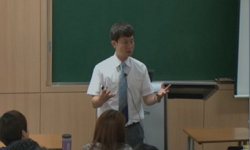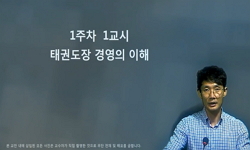태권도 도약격파는 빠른 속도로 달려가 점프하여 다양한 형태의 발차기를 표현할 수 있으며, 발과 주먹을 사용하여 체공상태에서 보다 많은 격파물을 격파하는 발차기다. 많은 격파물을 격...
http://chineseinput.net/에서 pinyin(병음)방식으로 중국어를 변환할 수 있습니다.
변환된 중국어를 복사하여 사용하시면 됩니다.
- 中文 을 입력하시려면 zhongwen을 입력하시고 space를누르시면됩니다.
- 北京 을 입력하시려면 beijing을 입력하시고 space를 누르시면 됩니다.

태권도 국가대표시범단원과 대학시범단원의 도약격파 수행 시 나타나는 COM과 후경각의 운동학적 특성비교 = Comparison of Kinetic Characteristics of COM and Retroversion Angle between National Taekwondo Demonstration Team Members and College Taekwondo Demonstration Team Members when Perform Jumping Break
한글로보기https://www.riss.kr/link?id=A104182392
- 저자
- 발행기관
- 학술지명
- 권호사항
-
발행연도
2017
-
작성언어
Korean
- 주제어
-
등재정보
KCI등재
-
자료형태
학술저널
-
수록면
135-148(14쪽)
-
KCI 피인용횟수
2
- DOI식별코드
- 제공처
- 소장기관
-
0
상세조회 -
0
다운로드
부가정보
국문 초록 (Abstract)
태권도 도약격파는 빠른 속도로 달려가 점프하여 다양한 형태의 발차기를 표현할 수 있으며, 발과 주먹을 사용하여 체공상태에서 보다 많은 격파물을 격파하는 발차기다. 많은 격파물을 격파하기 위해서 높은 점프가 요구 될 것이며, 점프높이 상승을 위해서는 많은 변인들이 영향을 미치게 된다. 그 중 도약하는 동안 COM(Center of Mass)의 높이와 수평, 수직 선속도, 후경각 등은 수평의 속도를 수직으로 변환하여 점프하는데 매우 중요한 변인이라고 할 수 있을 것이다. 하지만 이런 변인들에 대한 연구는 대부분 높이뛰기와 같은 육상종목에서 연구되어 왔으며 태권도 발차기에 접목된 연구는 없었다. 본 연구는 태권도 도약격파에서 나타나는 COM과 후경각의 변인을 파악하여 효과적인 공중동작을 하기 위한 요령을 탐색하고, 이러한 요령들을 잘 활용하는 효율적인 수련법을 정량화된 데이터의 제시를 통해 고안하는데 있다. 실험참가자는 판단 추출법에 의해 국가대표시범단 7명과 대학시범단 7명으로 하였다. 변인분석을 위하여 Motion Analysis사의 Motion capture system을 사용 하였다. 그룹 간 변인들에 대한 차이 분석은 독립 t-검정을 사용하였다. 두 그룹 간 COM의 높이에서 통계적인 차이가 나타났으며, X축, Z축 속도에서 통계적인 차이가 나타났다. 또한 Trunk의 후경각도에서도 통계적 차이가 나타났다. 이 같은 결과로 볼 때 뛰어앞차기 수행 시 도약구간에서는 COM을 하강시키며 달리다가 발구름 이후 빠르게 상승시켜야한다. 도약구간의 COM X축 속도를 빠르게 하고 발구름 구간을 거치면서 Z축 속도까지 빠르게 유지해야 한다. 도약구간 발생한 운동에너지가 위치에너지로 변환하는 과정에서 발구름 접지 시 후경각을 크게 만들어야 한다.
다국어 초록 (Multilingual Abstract)
Taekwondo`s jumping break can express diverse forms of kicks running with high speed and jumping, and is a kick that breaks more objects using fists and feet in the air. To break more objects, the high jumping ability is required and to increase the j...
Taekwondo`s jumping break can express diverse forms of kicks running with high speed and jumping, and is a kick that breaks more objects using fists and feet in the air. To break more objects, the high jumping ability is required and to increase the jumping ability, many variables exert the influence. During the jump, the height and level of COM, vertical lineal velocity, retroversion angle, etc. during the jump are very important variable in jumping converting the horizontal velocity to vertical. However, most of researches studying about those kinds of variables are conducted in the track and field events and there is no research grafted with Taekwondo kick. The purpose of this study is to provide effective practice methods and the quantitative data by identifying the variables of COM and retroversion angle appeared in Taekwondo`s jumping break. The participants in the experiment were 7 Korean National Taekwondo Demonstration Team members and 7 College Taekwondo Demonstration Team members. They were selected using judgment sampling. To analyze the variables, Motion Capture system of Motion Analysis was used. To see the differences of the variables between the two group, the independent sample t-test was used. The statistical difference was represented in the height of COM between the two groups, also the statistical difference was represented in the velocities of X-axis and Z-axis. In addition, the statistical difference was represented in the retroversion angles of the trunk. Considering these results, when performing the jumping break, one should run with lowering COM in the jumping section and should jump quickly after rolling the feet. The X-axis velocity of COM should be increased in the jumping section with maintaining high velocity of Z-axis while passing the feet rolling section. In the process of converting the kinetic energy generated in jumping section to the potential energy, should make the retroversion angle large when grounding of feet rolling.
참고문헌 (Reference)
1 성낙준, "포스베리 높이뛰기의 발구름 동작에 관한 운동역학적 분석" 서울大學校 大學院 1991
2 김태삼, "멀리뛰기 도움닫기 최종 3스텝의 운동학적 요인이 발구름 동작과 기록에 미치는 영향" 韓國體育大學校 大學院 1999
3 성낙준, "높이뛰기 기술의 생체 역학적 분석 (II)" 한국체육과학연구원 1989
4 이진택, "남자 높이뛰기 성공과 실패시 발구름 국면의 운동학적 요인에 대한 Variability 분석" 한국스포츠리서치 18 (18): 79-90, 2007
5 도호영, "국가대표 높이뛰기 선수들의 발구름 동작에 관한 운동학적 분석" 한국체육학회 41 (41): 839-852, 2002
6 Hay, J. G., "The biomechanics of sports techniques" Prentice Hall 1985
7 이진택, "Stefan Holm의 높이뛰기 발구름 동작에서의 충격력과 상지와 하지 분절의 운동학적 분석" 한국운동역학회 21 (21): 97-105, 2011
8 Dapena, J., "Mechanics of translations in the fosbury flop" 12 (12): 37-44, 1980
9 Carr, G., "Mechanics of sport: a practitioner’s guide" Human Kinetics 1997
10 Antekolovic, L., "Longitudinal follow-up of kinematic parameters in the high jump-A case study" 21 (21): 27-37, 2006
1 성낙준, "포스베리 높이뛰기의 발구름 동작에 관한 운동역학적 분석" 서울大學校 大學院 1991
2 김태삼, "멀리뛰기 도움닫기 최종 3스텝의 운동학적 요인이 발구름 동작과 기록에 미치는 영향" 韓國體育大學校 大學院 1999
3 성낙준, "높이뛰기 기술의 생체 역학적 분석 (II)" 한국체육과학연구원 1989
4 이진택, "남자 높이뛰기 성공과 실패시 발구름 국면의 운동학적 요인에 대한 Variability 분석" 한국스포츠리서치 18 (18): 79-90, 2007
5 도호영, "국가대표 높이뛰기 선수들의 발구름 동작에 관한 운동학적 분석" 한국체육학회 41 (41): 839-852, 2002
6 Hay, J. G., "The biomechanics of sports techniques" Prentice Hall 1985
7 이진택, "Stefan Holm의 높이뛰기 발구름 동작에서의 충격력과 상지와 하지 분절의 운동학적 분석" 한국운동역학회 21 (21): 97-105, 2011
8 Dapena, J., "Mechanics of translations in the fosbury flop" 12 (12): 37-44, 1980
9 Carr, G., "Mechanics of sport: a practitioner’s guide" Human Kinetics 1997
10 Antekolovic, L., "Longitudinal follow-up of kinematic parameters in the high jump-A case study" 21 (21): 27-37, 2006
11 Milan, C., "Kinematic dynamic analysis of the takeoff action in the long jump" 137 : 4443-4445, 1997
12 Ae, M., "Biomechanical analysis of the preparatory motion for takeoff in the Fosbury Flop" 2 (2): 66-77, 1986
동일학술지(권/호) 다른 논문
-
태권도 역품새 수련이 초등학생의 기초체력, 작업 기억력 및 전환능력에 미치는 영향
- 국기원
- 안효석 ( An Hyo-seok )
- 2017
- KCI등재
-
태권도 아카이브 구축방안: 연구, 교육, 심사를 중심으로
- 국기원
- 김봉경 ( Kim Bong-gyung )
- 2017
- KCI등재
-
태권도 사범의 직무스트레스가 직무만족 및 직무몰입에 미치는 영향
- 국기원
- 이상인 ( Lee Sang-in )
- 2017
- KCI등재
-
대학 태권도 선수의 완벽주의 성향과 사회적지지, 탈진의 구조적 관계
- 국기원
- 박종화 ( Park Jong-hwa )
- 2017
- KCI등재
분석정보
인용정보 인용지수 설명보기
학술지 이력
| 연월일 | 이력구분 | 이력상세 | 등재구분 |
|---|---|---|---|
| 2026 | 평가예정 | 재인증평가 신청대상 (재인증) | |
| 2020-01-01 | 평가 | 등재학술지 유지 (재인증) |  |
| 2017-01-01 | 평가 | 등재학술지 선정 (계속평가) |  |
| 2015-01-01 | 평가 | 등재후보학술지 선정 (신규평가) |  |
학술지 인용정보
| 기준연도 | WOS-KCI 통합IF(2년) | KCIF(2년) | KCIF(3년) |
|---|---|---|---|
| 2016 | 1.19 | 1.19 | 1.25 |
| KCIF(4년) | KCIF(5년) | 중심성지수(3년) | 즉시성지수 |
| 1.23 | 1.22 | 0.917 | 0.13 |





 KCI
KCI KISS
KISS







